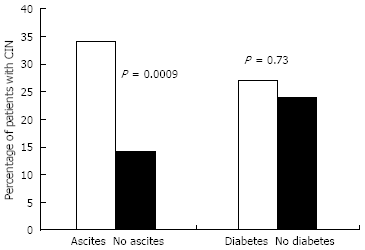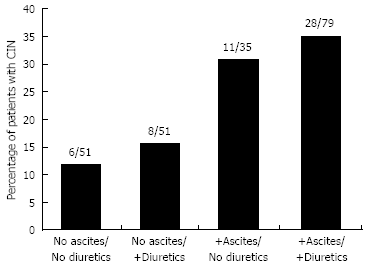Risk of contrast-induced nephropathy in hospitalized patients with cirrhosis
- PMID: 19322918
- PMCID: PMC2665139
- DOI: 10.3748/wjg.15.1459
Risk of contrast-induced nephropathy in hospitalized patients with cirrhosis
Abstract
Aim: To evaluate the incidence of contrast-induced nephropathy (CIN) in cirrhotic patients and to identify risk factors for the development of CIN.
Methods: We performed a retrospective review of 216 consecutive patients with cirrhosis who underwent computed tomography (CT) with intravenous contrast at the University of Rochester between the years 2000-2005. We retrospectively examined factors associated with a high risk for CIN, defined as a decrease in creatinine clearance of 25% or greater within one week after receiving contrast.
Results: Twenty-five percent of our patients developed CIN, and 74% of these patients had ascites seen on CT. Of the 75% of patients who did not develop CIN, only 46% had ascites. The presence of ascites was a significant risk factor for the development of CIN (P = 0.0009, OR 3.38, 95% CI 1.55-7.34) in multivariate analysis. Patient age, serum sodium, Model for End-stage Liver Disease score, diuretic use, and the presence of diabetes were not found to be significant risk factors for the development of CIN. Of the patients who developed CIN, 11% developed chronic renal insufficiency, defined as a creatinine clearance less than baseline for 6 wk.
Conclusion: Our results suggest that in hospitalized cirrhotic patients, especially those with ascites, the risk of CIN is substantial.
Figures
Similar articles
-
Incidence of contrast-induced nephropathy in intensive care patients undergoing computerised tomography and prevalence of risk factors.Anaesth Intensive Care. 2009 Nov;37(6):968-75. doi: 10.1177/0310057X0903700613. Anaesth Intensive Care. 2009. PMID: 20014604
-
Incidence of contrast material-induced nephropathy after neuroendovascular procedures.Radiology. 2014 Dec;273(3):853-8. doi: 10.1148/radiol.14131104. Epub 2014 Aug 1. Radiology. 2014. PMID: 25102293
-
Computed tomography scans with intravenous contrast: low incidence of contrast-induced nephropathy in blunt trauma patients.J Trauma Acute Care Surg. 2014 Aug;77(2):226-30. doi: 10.1097/TA.0000000000000336. J Trauma Acute Care Surg. 2014. PMID: 25058246
-
The clinical epidemiology of contrast-induced nephropathy.Cardiovasc Intervent Radiol. 2005;28 Suppl 2:S3-11. doi: 10.1007/s00270-005-0196-8. Cardiovasc Intervent Radiol. 2005. PMID: 16419277 Review.
-
The Incidence and Associated Risk Factors of Contrast-Induced Nephropathy after Contrast-Enhanced Computed Tomography in the Emergency Setting: A Systematic Review.Life (Basel). 2022 Jun 1;12(6):826. doi: 10.3390/life12060826. Life (Basel). 2022. PMID: 35743857 Free PMC article. Review.
Cited by
-
INASL-ISN Joint Position Statements on Management of Patients with Simultaneous Liver and Kidney Disease.J Clin Exp Hepatol. 2021 May-Jun;11(3):354-386. doi: 10.1016/j.jceh.2020.09.005. Epub 2020 Oct 9. J Clin Exp Hepatol. 2021. PMID: 33994718 Free PMC article. Review.
-
Surgery in a patient with liver disease.J Clin Exp Hepatol. 2012 Sep;2(3):238-46. doi: 10.1016/j.jceh.2012.05.003. Epub 2012 Sep 21. J Clin Exp Hepatol. 2012. PMID: 25755440 Free PMC article. Review.
-
Risk of acute kidney injury after transarterial chemoembolisation in hepatocellular carcinoma patients: A nationwide population-based cohort study.Eur Radiol. 2017 Nov;27(11):4482-4489. doi: 10.1007/s00330-017-4893-x. Epub 2017 Jun 7. Eur Radiol. 2017. PMID: 28593432
-
Coronary Intervention Outcomes in Patients with Liver Cirrhosis.Curr Cardiol Rep. 2025 Jan 4;27(1):2. doi: 10.1007/s11886-024-02163-x. Curr Cardiol Rep. 2025. PMID: 39754700 Free PMC article. Review.
-
Acute kidney injury in patients with cirrhosis: Acute Disease Quality Initiative (ADQI) and International Club of Ascites (ICA) joint multidisciplinary consensus meeting.J Hepatol. 2024 Jul;81(1):163-183. doi: 10.1016/j.jhep.2024.03.031. Epub 2024 Mar 26. J Hepatol. 2024. PMID: 38527522 Free PMC article. Review.
References
-
- Ginès A, Escorsell A, Ginès P, Saló J, Jiménez W, Inglada L, Navasa M, Clària J, Rimola A, Arroyo V. Incidence, predictive factors, and prognosis of the hepatorenal syndrome in cirrhosis with ascites. Gastroenterology. 1993;105:229–236. - PubMed
-
- Wu CC, Yeung LK, Tsai WS, Tseng CF, Chu P, Huang TY, Lin YF, Lu KC. Incidence and factors predictive of acute renal failure in patients with advanced liver cirrhosis. Clin Nephrol. 2006;65:28–33. - PubMed
-
- du Cheyron D, Bouchet B, Parienti JJ, Ramakers M, Charbonneau P. The attributable mortality of acute renal failure in critically ill patients with liver cirrhosis. Intensive Care Med. 2005;31:1693–1699. - PubMed
-
- Alessandria C, Ozdogan O, Guevara M, Restuccia T, Jiménez W, Arroyo V, Rodés J, Ginès P. MELD score and clinical type predict prognosis in hepatorenal syndrome: relevance to liver transplantation. Hepatology. 2005;41:1282–1289. - PubMed
-
- Epstien M. Deranged renal function in liver disease. Contrib Nephrol. 1977;7:250–271. - PubMed
MeSH terms
Substances
LinkOut - more resources
Full Text Sources
Medical



